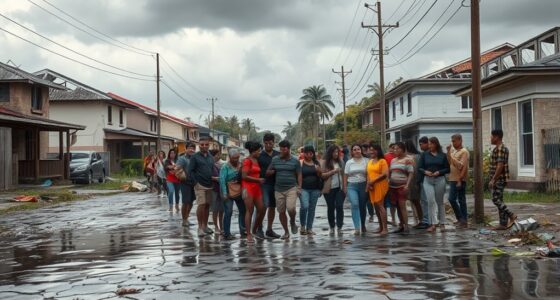The 2004 Indian Ocean tsunami highlighted the crucial need for early warning systems that can quickly detect undersea seismic activity and alert communities in time. Modern technology, like advanced sensors and buoys, helps monitor potential tsunamis and transmit data rapidly to alert centers. Community preparedness, such as knowing evacuation routes and practicing drills, enhances safety. Continuing will introduce you to how these systems work together to protect lives and reduce disaster impact.
Key Takeaways
- The 2004 tsunami exposed the lack of effective early warning systems in the Indian Ocean region.
- It highlighted the need for advanced detection technologies like seismic sensors and buoys.
- The disaster underscored the importance of community preparedness and early evacuation plans.
- Post-2004, regional warning systems were developed, integrating technology and public education.
- Ongoing efforts focus on improving detection accuracy and community resilience to prevent future tragedies.

The 2004 Indian Ocean tsunami revealed how essential early warning systems are in saving lives and reducing devastation. When the waves struck, many communities had little to no warning, which led to catastrophic loss of life and property. This tragedy highlighted the urgent need for effective tsunami detection methods and community preparedness strategies. By understanding how these systems work, you can appreciate their importance in safeguarding vulnerable coastal areas. Modern technology, including innovative materials and advanced sensors, continues to improve detection capabilities and response times, making early warning systems more reliable than ever. Tsunami detection plays a crucial role in early warning systems. Modern technology enables the monitoring of undersea seismic activity with sophisticated sensors and buoys that detect unusual disturbances. Once a potential tsunami-generating earthquake is identified, data is transmitted rapidly to warning centers. These centers analyze the information to determine if a tsunami is likely to occur and assess its possible impact. The speed and accuracy of tsunami detection are vital because every minute counts in issuing alerts and evacuating at-risk populations. Without reliable detection, communities remain vulnerable to the unpredictable nature of tsunamis, which can strike suddenly and with little warning.
Community preparedness is equally important in minimizing the disaster’s impact. Knowing what to do when an alert sounds can mean the difference between safety and tragedy. Your community should have clear evacuation plans, visible signage, and designated safe zones. Regular drills help residents become familiar with evacuation routes and procedures, reducing panic during an actual event. Education campaigns are essential too—they inform you about natural warning signs, such as a sudden receding of the water or a strong earthquake, which can precede a tsunami. When communities are prepared, they can respond swiftly, even before official warnings arrive, buying precious time to reach higher ground or safer areas.
The integration of tsunami detection and community preparedness creates a comprehensive early warning system that can save lives. When all components work together seamlessly, you and your neighbors are better equipped to respond effectively. Governments and organizations around the world have recognized this and are investing in advanced detection technology while promoting public education and community engagement. The goal is to create resilient communities that can withstand and quickly recover from such natural disasters.
In essence, the lessons from the 2004 tsunami underscore that early warning systems are not just about technology—they’re about empowering communities to act swiftly and confidently. By understanding how tsunami detection works and actively participating in preparedness efforts, you help build a safer environment for everyone living in vulnerable coastal regions. This proactive approach is your best defense against the devastating power of tsunamis.
Frequently Asked Questions
How Effective Were International Coordination Efforts Post-Tsunami?
International coordination efforts after the tsunami critically improved emergency response by fostering cross-border collaboration. You see, countries now work together more effectively, sharing vital information and resources quickly. This enhanced cooperation helps save lives and reduces damage during future disasters. While challenges remain, these efforts demonstrate a stronger global commitment to emergency response, ensuring that nations support each other better when disasters strike, ultimately making communities more resilient.
What Role Did Local Communities Play in Early Warning Dissemination?
Ever wondered how local communities helped during the tsunami? You’d see them actively participate in early warning dissemination, playing a crucial role in urgent response. Their community participation ensured messages were clear and timely, reaching residents quickly. By sharing essential information locally, they increased awareness and preparedness, ultimately saving lives. Don’t underestimate the power of local action—it’s often the first line of defense in disaster situations.
Were Any Technological Innovations Proposed After the 2004 Tsunami?
After the 2004 tsunami, new technological innovations were proposed, including advanced seismic sensors and improved communication networks. You’d see these upgrades aimed at detecting early warning signs more accurately and transmitting alerts faster. These innovations help guarantee communities are better prepared and can respond swiftly, minimizing damage and saving lives. Implementing these systems strengthens early warning efforts, making them more reliable and effective in future tsunami threats.
How Did Cultural Differences Impact Warning Message Reception?
Cultural differences act like a tapestry, weaving diverse threads that shape warning perception. You might find that cultural communication influences how warning messages are received and understood. In some communities, signs of danger are respected, while others may dismiss alerts due to language barriers or distrust. Recognizing these cultural nuances is vital, ensuring warning messages resonate effectively across varied backgrounds, ultimately saving lives through better understanding and response.
What Long-Term Improvements Have Been Implemented Since 2004?
Since 2004, you benefit from improved early warning technology, which now provides faster and more accurate alerts. Communities have also built resilience through better training, education, and infrastructure upgrades. These long-term improvements make certain you’re more prepared, can respond efficiently during emergencies, and reduce potential loss of life and property. Enhanced communication systems and international cooperation further strengthen the global effort to protect vulnerable populations from future tsunamis.
Conclusion
By understanding the failures and successes of the early warning systems, you realize they’re the lighthouse guiding us safely through stormy seas. The 2004 tsunami showed that technology alone isn’t enough; awareness and preparedness are your anchors. Moving forward, you hold the power to advocate for better systems, ensuring that when the waves come again, you’re not caught in their relentless tide but stand resilient, like a sturdy ship weathering the storm.










